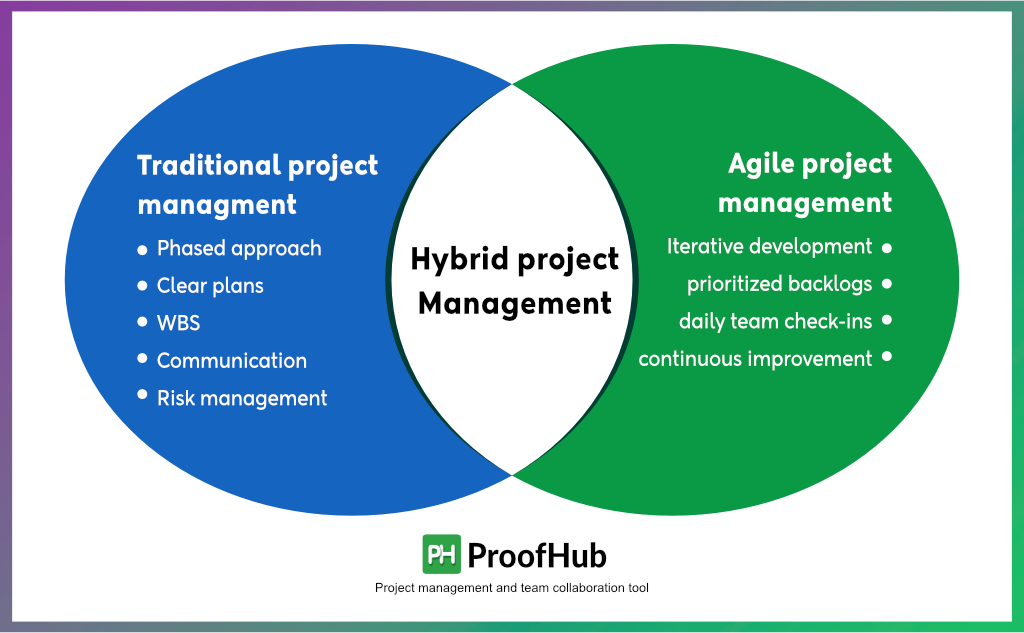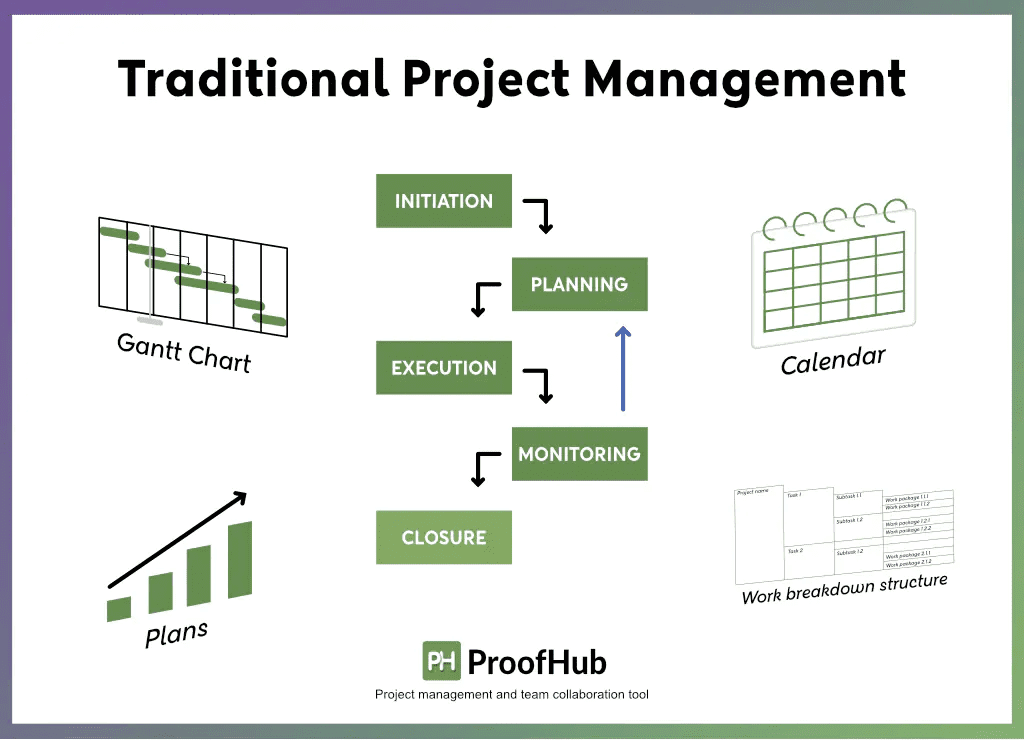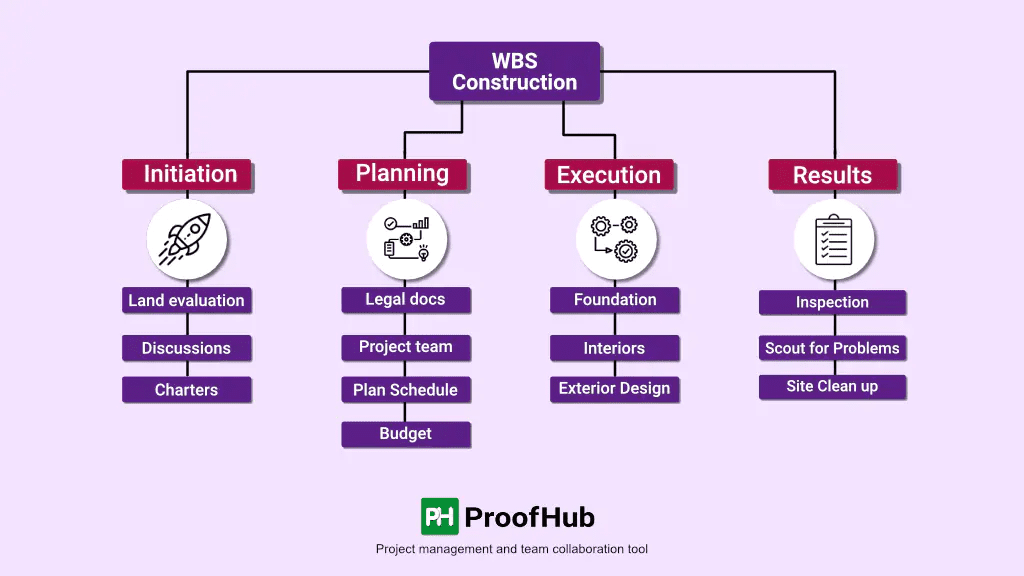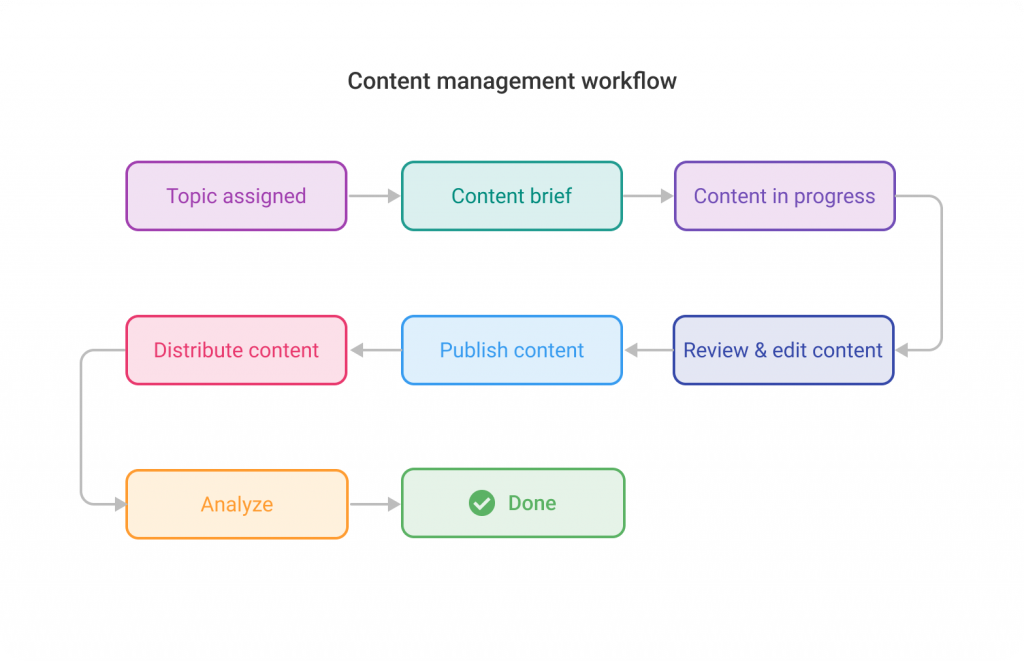Introduction
‘Hybrid project management’ is a term consistently making rounds in corporate social circles of managers in the past few years.
But what exactly is it?
Isn’t switching from the traditional Waterfall methodology to the modern Agile methodology enough that we have to learn about a new approach?
Things are already complex with Agile. Now, we are talking about combining two opposing methodologies for our projects.
Well, all I can say for now is that it is good for the project manager. Waterfall in planning and Agile in execution is the perfect combination. Later in this blog post, you will be able to find the argument for this statement.
In this blog post, we will talk about hybrid project management, its benefits, and examples. But to understand it, you also need to know about Waterfall and Agile as well. So, we will look into that as well.
What is hybrid project management?
Hybrid project management methodology is a combination of two different methodologies, primarily Agile and Waterfall. You can also combine Scrum and Kanban or Agile and DevOps or other methodologies. But when it comes to the traditional definition of hybrid project management, experts refer to combining Agile with Waterfall.

In hybrid project management, some stages of a project are managed using the Waterfall methodology, while others are managed using the Agile methodology.
Traditional vs agile vs hybrid project management
Here is a detailed explanation of the three approaches:
1. Traditional project management
Traditional or waterfall project management is a linear and sequential approach to managing a project; dating back to the 1970s. It follows the five-phase process to manage a project in order: initiation, planning, execution, monitoring, and closure. One phase should be completed before beginning the other.

This type of approach to project management is suitable for projects with fixed and rigid end goals and deliverables, specific budgets, and fixed timelines.
It means you know what you want to achieve from a project, have a clear idea of the project’s cost, and have a defined timeline due to a clear scope.
2. Agile project management
The problem in the project management world arrived when projects became complex. End-user involvement became of prime importance, and the market started changing rapidly.
Traditional project management says- you define all the project requirements during the initiation phase. Add or subtract the requirements as much as you want. Think as much as you want, but don’t make changes during the execution stage. Or say I don’t like the product on the day of launch. If you do, it will impact the project scope, time, and cost. Thus, Agile came into existence.

Agile project management is an incremental and iterative approach to managing a software development project; dating back to the early 2000s. It involves breaking a large project into small chunks and working in small repetitive cycles. Each small unit of work is continuously released for feedback from stakeholders and end-consumers.
In this way, if stakeholders or customers do not like something, they can share the feedback with the development team. The development team makes the changes accordingly in the next cycle to create products that stakeholders and customers want.
Agile project management is ideal for projects with changing project requirements or deliverables that have room for improvement.
The major difference between Waterfall and Agile on a project’s factors is that in Agile you cannot predict the project costs and timeline upfront because project scope is not fixed. You have flexible timelines, flexible costs, and changing scope in Agile.

Agile software development further has two prime frameworks to manage projects: Scrum and Kanban. Scrum includes working in fixed-length iterations known as sprints, whereas Kanban uses WIP limits to commit to work based on the team’s capacity in small repetitive cycles.
To learn more about Agile, check out this article on Agile project management: What is Agile project management?—A strength or weakness?
3. Hybrid project management
Hybrid project management combines Agile with Waterfall or vice versa to manage projects. It is because when companies switched from Waterfall to Agile, they didn’t want to let go of the control of Waterfall on project factors like cost, time, and scope. But at the same time, they wanted the flexibility of Agile. Thus, they combined Agile with Waterfall to create a hybrid project management.

The most popular way to implement hybrid project management is to plan a project in Waterfall but execute it in Agile. In this way, you have the stability of Waterfall but the flexibility of Agile.
This approach is ideal for large and complex projects with flexible scope and dynamic market space.
Read more: Traditional vs Agile Project Management Method: Which One is Right for Your Project?
Project management methodology comparison
The best methodology for a particular project will depend on several factors, such as the size and complexity of the project, the level of customer involvement, and the team’s skill set.
Here is a comparison of some of the most popular project management methodologies:
| Feature | Traditional | Agile | Hybrid |
| Planning | Upfront | Ongoing | Initial planning but not strictly fixed. Room for changes |
| Flow | Linear and sequential | Incremental and iterative | Blend of sequential, overlapping, iterative |
| Deliverables | Fixed | Changing | Fixed with space for improvement |
| Timelines and costs | Upfront fixed | Ongoing calculations | Some upfront idea with space for changes |
| Change management | Difficult, disrupts the flow | Quite easy as you are working in short cycles | Better than waterfall |
| End-user feedback | After the big launch | Throughout the development process | Throughout the development process |
| Client collaboration | Heavily during the planning phase and launch | Throughout the project | Blend of both |
| Project types | Well-defined fixed requirements, stable market environment | Evolving requirements, fast-paced market environment | Projects with some defined elements and room for change |
| Testing | After the development phase | After every sprint | After every sprint |
| Team collaboration | Within the department | Cross department collaboration | Both |
Hybrid project management examples
As per the 17th State of Agile report, 49% of organizations use hybrid project management to manage projects.
Let’s understand hybrid project management with an example.
Say you need to create an e-commerce website for company X.
- You have to create the following pages for the website:
- Feature to browse products
- User authentication system
- Shopping cart
- Checkout process
- Payment gateway integration
- Push notifications for order updates
- User profile management
- Each website page goes through these steps:
- Requirements gathering
- UX design (user testing can happen here)
- UI design (user testing can happen here)
- Development
- QA (user testing can happen here)
- Launch
Now, in hybrid project management, you gather the requirements from clients for the project just like you do in Waterfall, but you execute the project plan in Agile. You create a project plan using a work breakdown structure (WBS). This gives you a fair idea of the project’s scope, tasks, milestones, risks, dependencies, and life-cycle assessment.

In a hybrid approach, instead of a sequential UX-UI-dev-QA-launch process for all pages, you prioritize a few pages per sprint for iterative development.
You will prioritize the most valuable features of the most important web pages of the website and work parallelly on all these web pages to create a minimum valuable product (MVP).
A minimum viable product (MVP) is a product with a small set of features that delivers customer value.
You’ll iterate on UX for select pages, gather feedback, refine, and then hand off to UI for their own design and iteration cycle. Finally, it’s on to development, QA, and launch!
Now, what happened here is rather than working on the whole website in sequential order, you follow the cycle of planning, execution, and evaluation for each sprint in the software development process.

Check out: 20 Best Agile Project Management Tools for Project Managers
Benefits of hybrid project management
“The key to successful hybrid project management lies in finding the perfect balance between structure and flexibility, enabling teams to adapt to changing requirements while maintaining project control.” – David Johnson, Agile Coach
Hybrid project management offers a range of benefits. Have a look at them.
1. Improved adaptability & flexibility
Another major advantage of hybrid project management is it provides you the flexibility to adapt to change. If there are some changes in the original requirements of the webpage after feedback, you can work on those features in the next sprint and adjust the project timeline, scope, and cost accordingly. You have a master product lifecycle plan from traditional project management but you follow the cycle of planning, evaluation, and execution after every sprint.
2. Increased control & predictability
Managing work in sprints leads to better predictability because you know how much work is completed, the rework you need to do, the amount of work left, and at what pace your team is working. You can alter the project factors to achieve the desired outcomes.
Working in sprints helps you understand the users’ and stakeholders’ expectations better due to regular feedback. It results in a reduced amount of rework. It is said over time, an Agile team starts to know each other better because you daily communicate and reflect on the team performance in Sprint Retrospective. This leads to improved performance and better productivity.
3. Better risk management
As you are managing work in small chunks in sprints, not the whole project scope, timeline, and cost at once, it makes it easy to manage the risks associated with the projects. Whether it is related to the unavailability of team members, external supplier or vendor risks, resource constraints, or task dependencies, it is easy to plan for risk mitigation for a small scope and timeline. Thus, hybrid project management offers you better control over projects.
4. Increased project success rates
The biggest advantage of hybrid project management is it involves stakeholders’ and end-users’ feedback throughout the development stage. This reduces the risk of project failure. Even if you go wrong, your users will provide feedback with every release. This continuous feedback will help you make improvements in the next release.
5. Accelerated time-to-market
When you work on the most useful features of webpages and release them into the market, you have a basic version of the website of customer value in the market soon. This accelerates a product’s time-to-market and increases return on investment. This is great for long-term projects. You have MVP in the market with which real users are interacting while your Agile team is working on the advanced features and improvements in the backend.
Disadvantages of hybrid project management
Hybrid project management is a great approach to project management but it is not without disadvantages.
For example, traditional project management typically relies on fixed milestones and deliverables to measure progress. While Agile project management focuses on Sprint velocity and burn charts. Aligning and balancing these two approaches makes measuring project progress and performance challenging.
Here are some key disadvantages of hybrid project management:
- Complexity: Hybrid project management is more complex to execute than traditional or Agile methodology. It is because you need to integrate the processes, methods, and tools from both methodologies. It increases your project management work as you have to balance both approaches. This leads to inefficiencies.
- Lack of standardization: One of the biggest risks of hybrid project management is that there is no standard approach to implementing hybrid project management. This may lead to poor implementation of hybrid project management since you do not have a standard framework to execute the process. Additionally, you need knowledge of both methodologies to execute them properly.
- Training for a team: If your time is accustomed to Waterfall or Agile, it can be difficult for team members to understand new roles, responsibilities, and workflow processes. You need to train your team to new ways of working.
When to use hybrid project management?
Hybrid project management is not ideal for all types of projects. You need to decide what environments are an ideal approach to project management.
As a general rule, hybrid project management is ideal for long-term and complex projects with flexible project deliverables, budgets, and timelines. It is because despite knowing what you need to achieve there is a space for changes in the project scope based on the feedback and market changes.
Traditional project management is an ideal approach for projects with fixed deliverables, a defined timeline, a fixed budget, and stable market space. It is because you are not expecting any surprises.
For projects with changing scope, flexible timelines, stretching budgets, and dynamic market space, Agile is the right fit. It is because you do not know what you may have to work on.
Choosing the right project management method
Selecting the right project management methodology is crucial for a project’s success. There’s no one-size-fits-all answer, as the ideal method depends on various factors.
Here’s a breakdown to help you choose:

Check out: Top 10 software development project management tools 2024
Hybrid project management software & tools
Project management software helps you implement the principles and methods of a project management approach to manage projects and facilitate your team to work together.
Thus, you need powerful hybrid project management software to manage your projects. The key features you need in any project management software are the:
- Ability to create a project plan
- Gather stakeholders’ requirements in one place
- Centralized task management,
- File sharing
- Team collaboration
- Reports to measure the project’s progress
ProofHub is a powerful project management and team collaboration software that brings all of your projects, teamwork, and team communication to one place. It supports all three approaches: traditional, waterfall, and hybrid.

Here are the key features that can help you with hybrid project management:
- Gantt chart to create a project roadmap
- Kanban board to implement Agile frameworks like Scrum and Kanban
- Calendar for resource allocation visualization
- Custom workflow to help create a workflow
- Centralized task management to manage a project
- Built-in chat to communicate with the team in real-time
- Reports to overview the progress
- Project discussion and custom roles for stakeholder management
- Custom forms to collect feedback and manage issues
Conclusion
Hybrid project management is an approach to project management that blends Agile with Waterfall to offer you the best of both worlds. Additionally, you get the structure and organization of planning milestones out and the flexibility of Agile workflows in execution.
It means you have goals and mapped out plans for a project as you have in Waterfall and continuous release, continuous feedback, iterative development, and continuous improvement of Agile.
If you need the stability of Waterfall and flexibility of Agile, it is worth giving a try to hybrid project management.
ProofHub can be particularly helpful in navigating this approach as it offers features that cater to both Waterfall and Agile methodologies. It allows you to seamlessly switch between them or leverage a blend of both within a single project.
Manage your projects with ease using hybrid project management with ProofHub. Start your 14-day free trial (No credit card required).
Related articles
- 9 project management methodologies made simple
- What is agile project management?—A strength or weakness?
- Project management plan – everything you need to know about
FAQs
Why choose hybrid project management?
Hybrid project management offers you the best of both worlds. You have the stability and organization of Waterfall along with the flexibility and collaboration of Agile. It increases your chances of project success.
What is the role of leadership in driving hybrid project management success?
Leadership plays an important role in driving success for hybrid project management by providing clear direction, support, and guidance to the team to ensure that the integration of traditional and agile methodologies is executed effectively.
Can I combine Waterfall and Agile?
Yes, you can combine Waterfall with Agile. It includes planning a project using Waterfall and executing the project plan using Agile.
Can hybrid project management be applied to projects of any size or complexity?
Hybrid project management is ideal for large and medium projects of any complexity. It is not ideal for small projects; furthermore, you will not be able to utilize its benefits for them.

